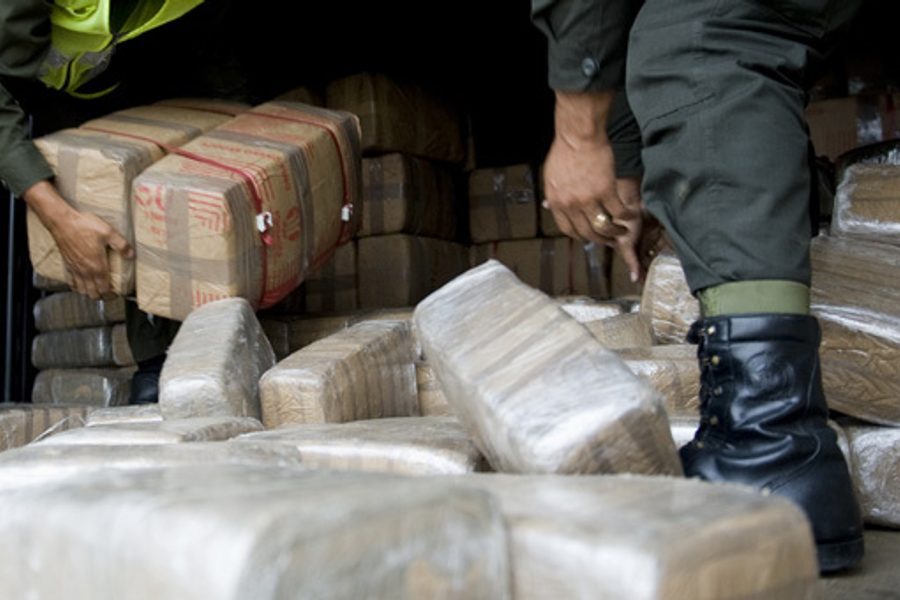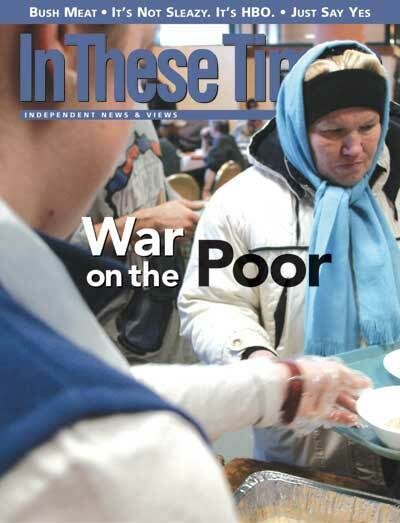
Numerous tightly rolled cannabis cigarettes were in evidence at a June 12 luncheon at the Heartland Institute, a libertarian policy think-tank in the Chicago Loop. These doobies were emblazoned on the cover of the provocative, plainspoken book, Saying Yes: In Defense of Drug Use by Jacob Sullum, a senior editor at Reason (“Free Minds and Free Markets”) magazine.
Yet the capacity crowd of 36 hardly appeared ready to kick back and smoke up: Mainly white men over 50 and conservatively dressed, they appeared more likely to break a bong over a slacker’s head than to consider Sullum’s argument against prohibitionism’s moral fearfulness and shoddy science.
Sullum’s thesis is that drug war policy has been ruled by “voodoo pharmacology,” the notion that certain chemicals can compel immoral behavior. Anti-drug messages depend upon the idea that illicit substances usurp users’ judgment and free will, and that any usage equals abuse. Punitive standards of interdiction and punishment compound the message that such substances inspire immoral behavior.
Sullum subjects this invocation of automatic turpitude to a withering critique. By examining the mythologized links between sloth, lust, madness, gluttony, and wrath and their purported chemical precursors (historically including tobacco and alcohol), he reveals the intellectual poverty of the right’s central conceit and retrieves the moral high ground ceded by uneasy legalization proponents.
————–
By discussing illicit substances in terms reserved for socially valued drugs (notably alcohol) Sullum is able to examine what psychiatrist Norman Zinberg termed “set and setting”—the combination of environment and expectations that determines the qualities of a drug experience. When alcohol prohibition’s failure discredited the “demon rum” fervor of its proponents, our extensive cultural experience with drinking allowed us to encourage “controlled use,” Sullum says.
The demonization of illicit drugs has resulted in a cultural naiveté that promotes irresponsible use and the black market. In Sullum’s terms, voodoo pharmacology recasts illicit substances (and their users) as the dreadful “other,” by averring that alcohol and drugs are fundamentally different, one controllable and humane, the other corrupting and devilish. This intellectual dishonesty, spoon-fed to children, contributes to rampant social misuse of alcohol and other substances, as anyone familiar with drug use among adolescents knows.
Moderate, responsible drug use is the elephant in the room of anti-drug zealotry. Thus, even a politician like former New Mexico Gov. Gary Johnson, who supported consideration of decriminalization, was unable to deviate from the Clinton administration’s script that drug use is always bad. While then-U.S. Sen. John Ashcroft (R-Mo.) saw no contradiction in his support of a major donor, St. Louis-based Anheuser-Busch, that sought to kill legislation limiting beer ads on television, calling alcohol “a product that’s in demand.” (Sullum finds Ashcroft’s self-justification “notably lacking in moral reflection.”)
If, as Sullum suggests, the fearsome otherness of illicit drugs is artificial and sags under analysis, then what allows the drug warriors to get away with such a transparent syllogism? At the Heartland Institute luncheon, Sullum dismantled the melodramatic, exaggerated morality that props up our denial of temperance’s possibilities.
————–
Sullum detects this in the equating of “sloth” with substance use, which was key to pre-Prohibition anti-alcohol propaganda and now is used to demonize cannabis as an aspiration killer suited to losers. Sullum examines “amotivational syndrome,” the concept that marijuana use creates “dropouts” disinterested in achievement, which provided the psychiatric underpinning for cannabis prohibition once the ’30s-era “reefer madness” typography of violence had been derided. Discredited by the ’90s, yet still key to anti-cannabis sentiment, amotivational syndrome seems inconsistent with the strange case of Progressive Insurance’s Peter Lewis, innovative businessman, billionaire and “functioning pothead.” While Lewis may be an extreme example, Sullum contends that rather than candidates for That 70s Show couch, average cannabis smokers are employed adults with family and community ties—and therefore have reason to conceal their preferred intoxicant.
Drugs linked with artificially induced violence—cocaine, crack and methamphetamine—initially seem a harder sell. Sullum argues that alcohol is the drug most associated with mayhem, but societies have long accepted the thesis of psychologist Craig McAndrew and anthropologist Robert Edgerton’s classic study Drunken Comportment: The variety of learned individual and cultural responses to alcohol confirms that “drinking does not necessarily beget violence.” Even the striking statistic that “about a third of convicted criminals are thought to have been drinking at the time of their offense,” fails to isolate the drinking activity from “personal and environmental factors that make both drinking and crime more likely.” Indeed, violent repeat offenders often cite their drinking or stimulant use as part of a “diminished capacity” defense (a ploy Sullum despises). The anti-cannabis fervor of the ’30s, Sullum notes, developed around lurid, racially oriented rumors regarding the killer weed’s propensity to inspire violence and fortify offenders with “Dutch courage.”
Sullum’s notion of voodoo pharmacology is founded on the historic attempt to lock in a causality that doesn’t exist. Such causality is a primary rationale for punishment. As noted gamesman William Bennett claims, “a non-addict’s drug use … is highly contagious.”
————–
As befits a writer entering this hall of mirrors, Sullum is a bit of a contradiction: He has impeccable credentials as a libertarian journalist yet notes that his own “modest but instructive” use of illicit intoxicants formed the “seed of my conviction that it’s reasonable to expect drug users to exercise self-control.” Thus, his observations on the Silent Majority of responsible users have an authority the anti-drug lobbies lack: “Prohibition renders [such users] invisible, because they fear the legal, social and economic consequences of speaking up.” His book gains dramatic texture and validity via interviews with such users, including MBAs, software engineers, publicists, journalists, academics, a truck driver, and a social worker—all of whom understandably requested anonymity.
He implies that these users represent the “average” consumer of illicit substances, whose drug use is unremarkable when incorporated into mainstream lives. Given that most politicians’ survival depends on maintaining the fiction that, as Sullum puts it, “drug users are different from you and me,” this silent drug-using majority ironically perpetuates the careers of those who promote the drug war. Meanwhile, the visible minority of troubled users become archetypes in the cultural landscape, enforcing the “lazy pothead” (or the acid casualty or the enraged cokehead) stereotype.
Sullum’s audience at the Heartland Society was receptive to his argument that most individuals have ample incentive (health, employment, community standing) to keep their drug use in check. With regard to counterarguments that decriminalization would result in numerous irresponsible new users, Sullum references this hidden population of socially functional drug users to call for dispassionate evaluations of prohibition’s costs and benefits. In the meantime, policymakers’ continued insistence that dangerous excess (rather than responsible use) establishes the norm results in a morally and intellectually stunted debate.
————–
The libertarian perspective provides a valuable intellectual counterpoint to the drug-war mythology but maintains a colder distance from adverse outcomes. For instance, Sullum argues that decriminalization of even stimulants like cocaine or opiates like heroin would not result in graver social conditions than the already dysfunctional landscape of the drug war (black-market violence, theft compelled by artificial “street prices,” and so forth).
Yet what of the inevitable spike of addictive personalities who lose control? Presumably, from a libertarian perspective, they would need to fend for themselves, an idea confirmed by Sullum, who noted in e-mail correspondence that he would not support diverting additional funds to beef-up clinical rehabilitation: “In practical terms, this kind of subsidy tends to undermine self-control.” Such a laissez-faire approach to dismantling drug prohibition could create new pockets of social pathology, undermining any decriminalization efforts in their infancy.
Sullum also declines to support a “sin tax” on decriminalized drug products, a frequent plank of left-leaning cannabis advocates. Yet any conceptualization of a post-drug war America must take into account the damage wrought on many communities by the war, as well as the need for a substantial addiction therapy regimen. Some kind of taxable “war chest” seems crucial to envisioning such a project.
Sullum avoids these thorny ambiguities of decriminalization for the simplicity of his ideas in Saying Yes. Indeed, this book’s sheer prescience makes any objection seem churlish. And in some microscopic way, the Heartland luncheon was like a hazy glimpse of the future, representing stirrings of consensus regarding how the drug war will end, even if it seems unimaginable for years to come.
With regard to the segregated personal destruction and diversion of law-enforcement resources that the drug war has produced, Heartland-style libertarians and ACLU-style civil libertarians are on the same side, even if arriving via different journeys. At a time when most “writing on drugs” consists of youthful preening memoirs, the coolheaded Sullum has produced a genuinely dangerous book—a white paper from that distant unimaginable future.
Yet the capacity crowd of 36 hardly appeared ready to kick back and smoke up: Mainly white men over 50 and conservatively dressed, they appeared more likely to break a bong over a slacker’s head than to consider Sullum’s argument against prohibitionism’s moral fearfulness and shoddy science.
Sullum’s thesis is that drug war policy has been ruled by “voodoo pharmacology,” the notion that certain chemicals can compel immoral behavior. Anti-drug messages depend upon the idea that illicit substances usurp users’ judgment and free will, and that any usage equals abuse. Punitive standards of interdiction and punishment compound the message that such substances inspire immoral behavior.
Sullum subjects this invocation of automatic turpitude to a withering critique. By examining the mythologized links between sloth, lust, madness, gluttony, and wrath and their purported chemical precursors (historically including tobacco and alcohol), he reveals the intellectual poverty of the right’s central conceit and retrieves the moral high ground ceded by uneasy legalization proponents.
————–
By discussing illicit substances in terms reserved for socially valued drugs (notably alcohol) Sullum is able to examine what psychiatrist Norman Zinberg termed “set and setting”—the combination of environment and expectations that determines the qualities of a drug experience. When alcohol prohibition’s failure discredited the “demon rum” fervor of its proponents, our extensive cultural experience with drinking allowed us to encourage “controlled use,” Sullum says.
The demonization of illicit drugs has resulted in a cultural naiveté that promotes irresponsible use and the black market. In Sullum’s terms, voodoo pharmacology recasts illicit substances (and their users) as the dreadful “other,” by averring that alcohol and drugs are fundamentally different, one controllable and humane, the other corrupting and devilish. This intellectual dishonesty, spoon-fed to children, contributes to rampant social misuse of alcohol and other substances, as anyone familiar with drug use among adolescents knows.
Moderate, responsible drug use is the elephant in the room of anti-drug zealotry. Thus, even a politician like former New Mexico Gov. Gary Johnson, who supported consideration of decriminalization, was unable to deviate from the Clinton administration’s script that drug use is always bad. While then-U.S. Sen. John Ashcroft (R-Mo.) saw no contradiction in his support of a major donor, St. Louis-based Anheuser-Busch, that sought to kill legislation limiting beer ads on television, calling alcohol “a product that’s in demand.” (Sullum finds Ashcroft’s self-justification “notably lacking in moral reflection.”)
If, as Sullum suggests, the fearsome otherness of illicit drugs is artificial and sags under analysis, then what allows the drug warriors to get away with such a transparent syllogism? At the Heartland Institute luncheon, Sullum dismantled the melodramatic, exaggerated morality that props up our denial of temperance’s possibilities.
————–
Sullum detects this in the equating of “sloth” with substance use, which was key to pre-Prohibition anti-alcohol propaganda and now is used to demonize cannabis as an aspiration killer suited to losers. Sullum examines “amotivational syndrome,” the concept that marijuana use creates “dropouts” disinterested in achievement, which provided the psychiatric underpinning for cannabis prohibition once the ’30s-era “reefer madness” typography of violence had been derided. Discredited by the ’90s, yet still key to anti-cannabis sentiment, amotivational syndrome seems inconsistent with the strange case of Progressive Insurance’s Peter Lewis, innovative businessman, billionaire and “functioning pothead.” While Lewis may be an extreme example, Sullum contends that rather than candidates for That 70s Show couch, average cannabis smokers are employed adults with family and community ties—and therefore have reason to conceal their preferred intoxicant.
Drugs linked with artificially induced violence—cocaine, crack and methamphetamine—initially seem a harder sell. Sullum argues that alcohol is the drug most associated with mayhem, but societies have long accepted the thesis of psychologist Craig McAndrew and anthropologist Robert Edgerton’s classic study Drunken Comportment: The variety of learned individual and cultural responses to alcohol confirms that “drinking does not necessarily beget violence.” Even the striking statistic that “about a third of convicted criminals are thought to have been drinking at the time of their offense,” fails to isolate the drinking activity from “personal and environmental factors that make both drinking and crime more likely.” Indeed, violent repeat offenders often cite their drinking or stimulant use as part of a “diminished capacity” defense (a ploy Sullum despises). The anti-cannabis fervor of the ’30s, Sullum notes, developed around lurid, racially oriented rumors regarding the killer weed’s propensity to inspire violence and fortify offenders with “Dutch courage.”
Sullum’s notion of voodoo pharmacology is founded on the historic attempt to lock in a causality that doesn’t exist. Such causality is a primary rationale for punishment. As noted gamesman William Bennett claims, “a non-addict’s drug use … is highly contagious.”
————–
As befits a writer entering this hall of mirrors, Sullum is a bit of a contradiction: He has impeccable credentials as a libertarian journalist yet notes that his own “modest but instructive” use of illicit intoxicants formed the “seed of my conviction that it’s reasonable to expect drug users to exercise self-control.” Thus, his observations on the Silent Majority of responsible users have an authority the anti-drug lobbies lack: “Prohibition renders [such users] invisible, because they fear the legal, social and economic consequences of speaking up.” His book gains dramatic texture and validity via interviews with such users, including MBAs, software engineers, publicists, journalists, academics, a truck driver, and a social worker—all of whom understandably requested anonymity.
He implies that these users represent the “average” consumer of illicit substances, whose drug use is unremarkable when incorporated into mainstream lives. Given that most politicians’ survival depends on maintaining the fiction that, as Sullum puts it, “drug users are different from you and me,” this silent drug-using majority ironically perpetuates the careers of those who promote the drug war. Meanwhile, the visible minority of troubled users become archetypes in the cultural landscape, enforcing the “lazy pothead” (or the acid casualty or the enraged cokehead) stereotype.
Sullum’s audience at the Heartland Society was receptive to his argument that most individuals have ample incentive (health, employment, community standing) to keep their drug use in check. With regard to counterarguments that decriminalization would result in numerous irresponsible new users, Sullum references this hidden population of socially functional drug users to call for dispassionate evaluations of prohibition’s costs and benefits. In the meantime, policymakers’ continued insistence that dangerous excess (rather than responsible use) establishes the norm results in a morally and intellectually stunted debate.
————–
The libertarian perspective provides a valuable intellectual counterpoint to the drug-war mythology but maintains a colder distance from adverse outcomes. For instance, Sullum argues that decriminalization of even stimulants like cocaine or opiates like heroin would not result in graver social conditions than the already dysfunctional landscape of the drug war (black-market violence, theft compelled by artificial “street prices,” and so forth).
Yet what of the inevitable spike of addictive personalities who lose control? Presumably, from a libertarian perspective, they would need to fend for themselves, an idea confirmed by Sullum, who noted in e-mail correspondence that he would not support diverting additional funds to beef-up clinical rehabilitation: “In practical terms, this kind of subsidy tends to undermine self-control.” Such a laissez-faire approach to dismantling drug prohibition could create new pockets of social pathology, undermining any decriminalization efforts in their infancy.
Sullum also declines to support a “sin tax” on decriminalized drug products, a frequent plank of left-leaning cannabis advocates. Yet any conceptualization of a post-drug war America must take into account the damage wrought on many communities by the war, as well as the need for a substantial addiction therapy regimen. Some kind of taxable “war chest” seems crucial to envisioning such a project.
Sullum avoids these thorny ambiguities of decriminalization for the simplicity of his ideas in Saying Yes. Indeed, this book’s sheer prescience makes any objection seem churlish. And in some microscopic way, the Heartland luncheon was like a hazy glimpse of the future, representing stirrings of consensus regarding how the drug war will end, even if it seems unimaginable for years to come.
With regard to the segregated personal destruction and diversion of law-enforcement resources that the drug war has produced, Heartland-style libertarians and ACLU-style civil libertarians are on the same side, even if arriving via different journeys. At a time when most “writing on drugs” consists of youthful preening memoirs, the coolheaded Sullum has produced a genuinely dangerous book—a white paper from that distant unimaginable future.
Mike Newirth is fiction editor of Bridge magazine and a contributor to The Baffler, the Chicago Reader and the anthology Boob Jubilee: The Cultural Politics of the New Economy.





